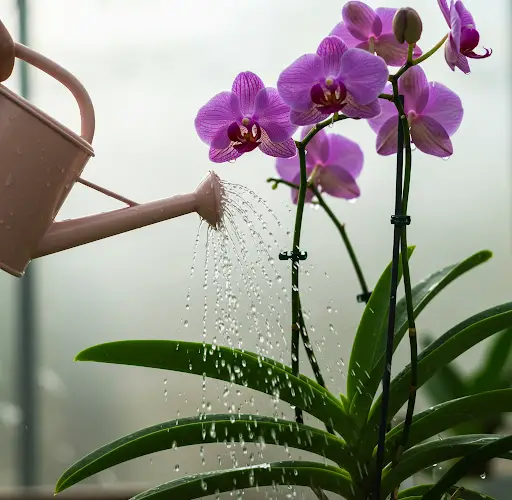Watering orchids is one of the most essential aspects of orchid care, as it directly impacts their blooming, leaf growth, and root development. Without proper and regular watering, orchids will struggle to thrive, and their ability to produce flowers will be significantly reduced. In this guide, I will explain the most effective watering techniques for orchids, highlight common mistakes to avoid, and share important tips to help your orchid stay healthy and vibrant.
Incorrect Watering Methods to Avoid
Before diving into the correct ways to water orchids, it is important to highlight some of the common mistakes that should be avoided at all costs. Using the wrong watering technique can lead to serious issues, including root rot, fungal infections, and yellowing leaves.
1. Overhead Watering
One of the most common mistakes people make is watering orchids from above. Pouring water directly over the plant causes water to accumulate between the leaves and in the stem. When water remains trapped in these areas for an extended period, it increases the risk of fungal infections, yellowing leaves, and overall plant deterioration.
2. Washing the Orchid Under a Faucet
Another incorrect method is rinsing the orchid under a running faucet. This technique allows excessive water to enter between the leaves and reach the stem, leading to the plant absorbing more moisture than it actually needs. As a result, the accumulated water can cause fungal infections, leaf decay, and premature wilting of flowers.
If you accidentally get water trapped between the leaves, always use a napkin or tissue to gently dry these areas. This simple step can prevent fungal growth and keep your orchid healthy.
How to Determine When Orchids Need Water
Understanding when to water your orchid is crucial to maintaining its health. Orchids have two types of roots: aerial roots and roots inside the pot. When checking for water needs, always examine the roots inside the pot and not the aerial roots. The color of the roots will indicate whether the orchid requires watering:
- Green roots: The orchid has enough moisture and does not need water.
- White or gray roots: The orchid is dry and requires watering.
- Shrinking or dehydrated roots: The plant is severely under-watered and needs immediate hydration.
Proper Orchid Watering Techniques
Now that we have covered the incorrect methods, let’s explore the best techniques for watering orchids effectively.
1. Watering from the Edge
The most recommended way to water an orchid is by pouring water slowly from the edge of the pot. This method ensures that water reaches the roots without getting trapped between the leaves and stem. Follow these steps:
- Gently pour about 100ml (half a glass) of water around the edges of the pot.
- Stop watering once you see water draining from the bottom of the pot.
- Avoid pouring water directly onto the plant’s stem or leaves.
- If water does accumulate between the leaves, use a napkin to soak up excess moisture.
This method allows the orchid to absorb the right amount of moisture while preventing overwatering and potential root rot.
2. Soaking Method (Dipping Technique)
Another effective watering method is the dipping technique, also known as the soaking method. This is particularly useful for orchids that are severely dehydrated or need an even distribution of moisture.
- Fill a bowl with lukewarm water.
- Place the orchid’s pot inside the bowl, ensuring that the roots are submerged.
- Leave the pot in the water for no more than 10 minutes.
- Remove the pot and let excess water drain completely before placing it back in its usual spot.
- Do not leave the orchid soaking for more than 10 minutes, as this can lead to excessive moisture retention and root rot.
Post-Watering Care
After watering your orchid, it is essential to ensure proper air circulation to prevent excessive humidity buildup, which can lead to fungal infections. Here’s what you can do:
- Place the orchid near a window that receives plenty of indirect sunlight.
- Ventilate the room by opening a window for at least 30 minutes to allow airflow around the plant.
- Avoid placing the orchid in direct sunlight immediately after watering, as this can cause stress to the plant.
Additional Watering Tips
- Water orchids in the morning: This allows the plant to absorb moisture throughout the day and reduces the risk of fungal infections that thrive in cool, damp conditions at night.
- Use room-temperature water: Cold water can shock the roots, while hot water can damage them. Lukewarm water is ideal.
- Avoid chlorinated water: If possible, use filtered or rainwater to prevent chemical buildup in the soil.
- Adjust watering frequency based on the season: Orchids require more frequent watering in the growing season (spring and summer) and less during the dormant period (fall and winter).
Conclusion
Proper watering is the key to maintaining a healthy and thriving orchid. By avoiding incorrect watering methods such as overhead watering and excessive soaking, and instead using techniques like watering from the edge or the dipping method, you can ensure that your orchid receives just the right amount of moisture.
Remember to always check the root color to determine when watering is necessary, and take care to ventilate the plant after watering. By following these simple yet effective practices, your orchid will develop strong roots, vibrant leaves, and beautiful long-lasting blooms.



